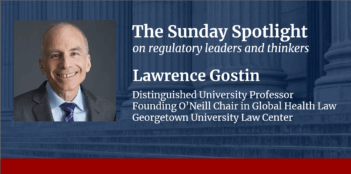
Regulators and policymakers review old rules and propose new guidelines for rationing ventilators.
“I owe my life to a ventilator,” David Lat, a patient recovering from COVID-19, told the media days after coming off the machine. Although ventilators can be lifesaving, hospitals might not have enough of these medical devices if the virus continues to spread or even if it later resurges. If patients in need outnumber available ventilators, how would treating physicians decide who gets the scarce resource?
State regulators and hospitals have revised their policies to prevent health care workers from having to make these decisions on the frontlines. But in the process, state authorities have had to grapple with how to implement fair criteria for determining which patients get access to ventilators.
In some states, such as Alabama and Washington, advocacy groups have challenged rationing policies that state agencies developed before the pandemic. These groups have argued that the agencies endorsed frameworks that discriminate against people with disabilities.
In Pennsylvania, however, Douglas White and his coauthors at the University of Pittsburgh School of Medicine have developed a regulatory framework for hospitals and states to adopt that does not explicitly consider disabilities or medical conditions.
White’s guidance—which the Pennsylvania Department of Health and a number of hospitals across the country have adopted—uses a point system to determine patients’ priority levels for access to ventilators. The Pennsylvania framework takes into account whether patients are likely to survive ventilation and be discharged from the hospital. The system also analyzes whether patients have underlying conditions that limit their life expectancies even if they survive COVID-19. Patients with lower scores receive higher priority because their initial and long-term survival outcomes are more promising than patients with higher scores.
But unlike other rationing policies, the Pennsylvania framework considers factors beyond survival outcomes. According to the policy, people who have jobs that are considered “vital to public health” should receive priority. If there are patients with the same score, the guidance recommends using age as a tiebreaker. “It is a valuable goal to give individuals equal opportunity to pass through the stages of life,” the policy states.
Although patients with underlying life-threatening conditions will not receive priority in Pennsylvania, White and his coauthors suggest that the policy is still inclusive. The guidance does not categorically exclude patients with disabilities and chronic diseases. The policy explains that categorically denying ventilator access would be unfair to patients with differing individual prognoses and would only engender distrust in the community.
The U.S. Department of Health and Human Services (HHS) warns that exclusionary policies also violate federal laws. In a recent bulletin, HHS’s Office for Civil Rights (OCR) reminds hospitals and state agencies that the federal Patient Protection and Affordable Care Act and the Rehabilitation Act of 1973 prohibit patients from being discriminated against on the basis of their disabilities or age. The bulletin states that medical decisions should be based on “individualized assessments” rather than on stereotypes about medical conditions or disabilities.
But some states may not satisfy the criteria reflected in the recent bulletin, especially those states that have emergency rationing policies that were drafted long before the COVID-19 pandemic.
In Alabama, a 2010 emergency operation plan lists specific “exclusion criteria” for deciding which patients get access to ventilators in a shortage. Under the guidelines, patients who have medical conditions including dementia or metastatic cancers may not be considered for ventilators. The policy also says that people with severe mental disabilities may be “poor candidates for ventilation support.”
The Alabama Disabilities Advocacy Program and other activists recently filed a complaint with OCR alleging that Alabama’s guidance is discriminatory. After reviewing Alabama’s 2010 guidance, OCR said that the policies would categorically allow hospitals to deny ventilators to patients based on their intellectual disabilities or age.
According to OCR, Alabama agreed to remove the policy and has already established a new guidance. OCR’s enforcement action against Alabama was the first such action the office has taken since HHS announced its recent bulletin cautioning states not to use exclusionary rationing policies.
Activists, however, have continued to challenge rationing policies in states across the nation.
Even in Pennsylvania, advocacy groups have filed a complaint arguing that the state’s interim rationing guidelines deprioritized people with disabilities. But OCR resolved this complaint after Pennsylvania revised its guidance earlier this month. In “version 2” of its guidelines, Pennsylvania adopted the framework that White and his coauthors at the University of Pittsburgh first proposed, namely prioritizing saving the most lives and life-years.
As state guidelines continue to be challenged and revised, the federal government has implemented policies to try to stop the need for rationing altogether.
The U.S. Food and Drug Administration, for example, has relaxed regulatory requirements limiting the ability of medical professionals to modify equipment that could function as ventilators. According to a recent agency guidance, manufacturers can modify devices traditionally used for other conditions—such as sleep apnea—to treat COVID-19 patients. The Federal Emergency Management Agency also issued a temporary final rule prohibiting distributors from exporting ventilators and other scarce resources out of the country without agency approval until August.
But if these federal efforts are unsuccessful at preventing a shortage of ventilators and other essential medical equipment, the American Medical Association (AMA) has updated its code of medical ethics to guide the stakeholders making rationing decisions.
Earlier this month AMA released a new guidance, recognizing that, during the pandemic, physicians cannot always follow the standard code of ethics to promote the well-being of every individual patient. The organization said that, during a public health crisis, physicians must “strike an ethically justifiable balance between the specific needs of their individual patients and the global needs of the community of patients overall.”



